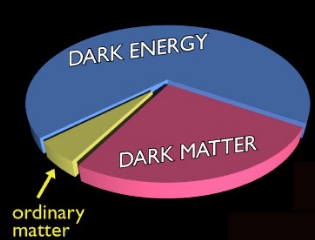Dark Matter
"I do not know what I may appear to the world; but to myself I seem to have been only like a boy playing on the seashore, and diverting myself in now and then finding a smoother pebble or a prettier shell than ordinary, whilst the great ocean of truth lay all undiscovered before me."
-Sir Isaac Newton, English mathematician and physicist (1642-1727)
What is Dark Matter?

The Composition of the Universe
We "see" visible matter because it is able to emit and reflect visible light. However, imagine matter that did not interact with light at all and was therefore, quite literally, invisible. This is what scientists today believe to be Dark Matter (DM). In fact, DM is most probably non-baryonic, meaning it does not interact with any electromagnetic radiation at all.
Even though we cannot visually observe it, scientists are convinced that 70-90% of matter in The Universe is non-baryonic DM and that ordinary luminous matter constitutes only a small fraction of The Universe's mass density.
Evidence of Dark Matter
Finding physical evidence of DM is difficult because it cannot be directly detected with any optical equipment. Even though it does not interact with light, DM still interacts gravitationally, and this quality helps verify its presence. If DM does exist, there must be more gravity present in The Universe than visible matter alone can produce.
Evidence of this "extra" gravity includes:
- The strange rotational velocities of stars in galactic disks can only be explained if much more mass is present in each galaxy.
- The relative bulk motions of galaxies combined with restrictions from nucleosynthesis show that the majority of the Universe's matter must be non-baryonic dark matter.
- The degree to which light is bent by galaxies and clusters indicates that 90% of the Matter in the Universe is missing.
- The density of the Universe is just right to make its geometry flat. Moreover, no viable theory of structure formation exists that does not contain a minimum amount of dark matter.


